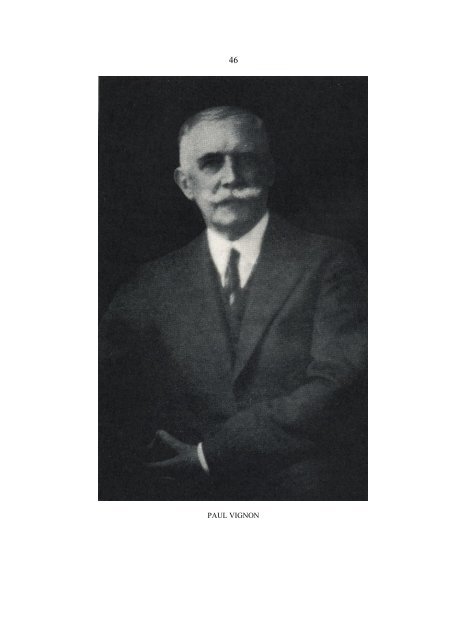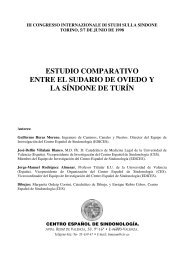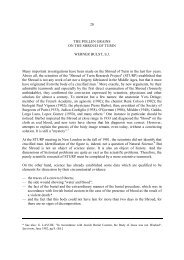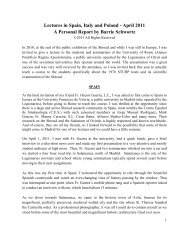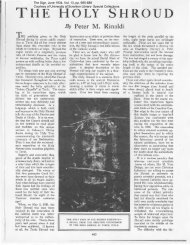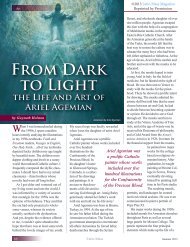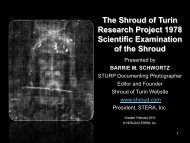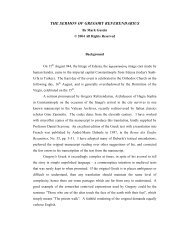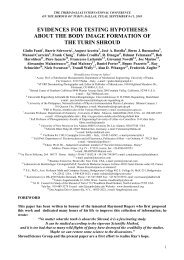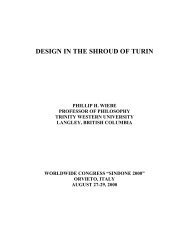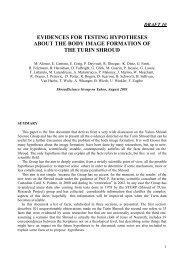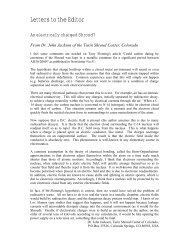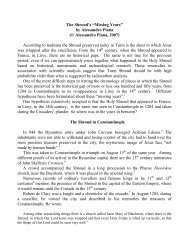Paul Vignon - The Shroud of Turin Website
Paul Vignon - The Shroud of Turin Website
Paul Vignon - The Shroud of Turin Website
You also want an ePaper? Increase the reach of your titles
YUMPU automatically turns print PDFs into web optimized ePapers that Google loves.
46PAUL VIGNON
47PAUL VIGNONREV. PAUL DE GAIL, S.J.Who was <strong>Paul</strong> <strong>Vignon</strong>?<strong>The</strong> brilliancy <strong>of</strong> a scholar is sometimes eclipsed by his modesty. Born in the 19thcentury, in the first half <strong>of</strong> the 20th century <strong>Paul</strong> <strong>Vignon</strong> produced many works onphilosophy and entymology; works which retain all their value, being cited to this day.Those who admire his contributions and would like to know a bit more about the man,will find in these brief notes some indications concerning his personal qualities and theelements <strong>of</strong> his principal writings. We thank Pr<strong>of</strong>. <strong>Vignon</strong>'s family, who so kindlycommunicated this information to me as well as permission to reproduce his photograph.A glance at this photograph is already revealing. This personage seated simply in anarmchair appears settled in an intense consciousness <strong>of</strong> himself, in the noble andTeilhardian sense <strong>of</strong> the term; a man endowed with a singular force <strong>of</strong> character. In hispose and his penetrating eyes, one reads a pr<strong>of</strong>ound power <strong>of</strong> reflection combined with avigorous temperament. While his features are etched by his tireless efforts to acquirescience, he yet retains an easy and distinguished manner. When this photo was made,<strong>Vignon</strong>'s career was virtually at its close; his hair is turning white. But the energeticcountenance evinces an uncommon strength <strong>of</strong> will and superior achievements. Hisglance, frank and scrutinizing, even piercing, betrays the enormous curiosity <strong>of</strong> ascientist, an intellectual probity, a flawless moral integrity.In fact, by preference and through studies, <strong>Paul</strong> <strong>Vignon</strong> was a researcher. As a biologistenraptured by the enigmas <strong>of</strong> nature, as a philosopher <strong>of</strong> very acute sensibility, as a man<strong>of</strong> deep religious faith, he rejoiced whenever, in his quests, spiritual explanations wererevealed. <strong>The</strong> psychology apparent in this eloquent portrait reflects exactly the man'spr<strong>of</strong>essorial career.<strong>Paul</strong> <strong>Vignon</strong> and the <strong>Shroud</strong> <strong>of</strong> Christ<strong>Paul</strong> <strong>Vignon</strong> was born in Lyon on November 11, 1865. His studies and career wereoriented toward science, to which he gave himself entirely.In 1924 he was appointed pr<strong>of</strong>essor on the Faculty <strong>of</strong> Philosophy <strong>of</strong> the InstitutCatholique de Paris, where until his death he occupied the chair <strong>of</strong> "Philosophy <strong>of</strong>Zoology and Introduction to the Philosophy <strong>of</strong> Biology". Simultaneously, for severalyears he was at the Sorbonne as zoology assistant to Pr<strong>of</strong>. Yves Delage (1854-1920), hisinstructor
48and thesis patron.A strong bond <strong>of</strong> friendship formed between the Christian and the non-believer, andeventually a group <strong>of</strong> biologists cooperated with them to formulate the vaporgraphhypothesis as the cause <strong>of</strong> the corporal image inscribed on the Linen. <strong>The</strong>ir discoveryproved to be one <strong>of</strong> the most decisive demonstrations <strong>of</strong> the authenticity <strong>of</strong> the <strong>Shroud</strong> <strong>of</strong>Christ.It was Yves Delage who, on 21 April 1902, startled the Academy <strong>of</strong> Science with thenow-famous report on the <strong>Shroud</strong>.And in 1902, after careful study <strong>of</strong> the first photograph <strong>of</strong> the <strong>Shroud</strong>, made by SecondoPia in 1898, <strong>Vignon</strong> published his first book: <strong>The</strong> <strong>Shroud</strong> <strong>of</strong> Christ. <strong>The</strong>n he remainedsilent on this subject for nearly thirty years.During the <strong>Shroud</strong> exhibition <strong>of</strong> 1933, he was one <strong>of</strong> the few scientists admitted, for onewhole night, to minutely examine the relic. This gained for us the great work <strong>of</strong> 1938: <strong>The</strong>Holy <strong>Shroud</strong> <strong>of</strong> <strong>Turin</strong>: Science, Archeology, History, Iconography, Logic, for which theFrench Academy awarded him a prize.In this second work he seeks to supplement the argument for authenticity byarcheological data, and essays a connection between the <strong>Shroud</strong> and the most ancientpaintings and mosaics representing Christ; a filiation which no one is obliged to accept,even though so many commentators have taken up the idea from time to time. It would begreatly surprising if the ancient artists, viewing the <strong>Shroud</strong>'s negative image in their totalignorance <strong>of</strong> photographic inversion, could have produced a positive portrait in which thenegative model could be recognized.In 1932 <strong>Vignon</strong> became Corresponding Member <strong>of</strong> the Pontifical Academy <strong>of</strong> Sciences.In the same year he organized the International Commission <strong>of</strong> the Holy <strong>Shroud</strong>, <strong>of</strong> whichhe was Secretary General. Later, the Prince <strong>of</strong> Piedmont appointed him president <strong>of</strong> thisCommission.In this capacity he carried on a long correspondence—from 1931 to 1939—with CardinalPacelli; and telegrams were exchanged between them when the Cardinal acceded to thepapal throne with the name <strong>of</strong> Pius XII.His correspondents included the King <strong>of</strong> Italy, Card. Tisserand, the philosopher Bergson,writers such as Mauriac and Claudel, and many other men <strong>of</strong> learning.Although uncertainty still lies over his archeological references relative to the <strong>Shroud</strong>,and although the chemical process put forth in his vaporgraph theory is due for revision,the fact remains that <strong>Paul</strong> <strong>Vignon</strong> was the first true savant to confront the mystery <strong>of</strong> theHoly <strong>Shroud</strong> in an attempt to decipher its secrets scientifically. And in a
49way he succeeded; today's increasing acceptance <strong>of</strong> the <strong>Shroud</strong>'s authenticity can belargely attributed to his groundwork.<strong>The</strong> combination <strong>of</strong> certifiable facts permitted the Sovereign Pontiff Pius XI to publiclyproclaim, in 1936, that the internal critique <strong>of</strong> the <strong>Shroud</strong> showed, without any doubt, thatit had belonged to the Crucified Victim <strong>of</strong> Golgotha.A long time before this, <strong>Paul</strong> <strong>Vignon</strong> had appealed to radiology, hoping for informationregarding the nature <strong>of</strong> the aromatics and <strong>of</strong> the vestiges <strong>of</strong> blood. Though he did not liveto see it, his desire was fulfilled when <strong>Turin</strong>'s Pr<strong>of</strong>. Baima Bollone identified humanblood on the <strong>Shroud</strong>. <strong>The</strong> examinations conducted in <strong>Turin</strong> after the 1978 Congress, thevery sophisticated American research and the continuing work in Europe, all seem to be aprolongation <strong>of</strong> the studies <strong>of</strong> <strong>Paul</strong> <strong>Vignon</strong>, whose faith in the verity <strong>of</strong> the Holy <strong>Shroud</strong>was total and definite from the first encounter.<strong>Paul</strong> <strong>Vignon</strong>, Biologist<strong>Paul</strong> <strong>Vignon</strong>'s patient analyses <strong>of</strong> the Linen and the contribution to its identity wouldsuffice to establish his fame as a scholar and a Christian. But the variety <strong>of</strong> the spheres <strong>of</strong>his scientific research, as well as the minute precision with which he pursued his studies,arouse our admiration.His principal and great work in philosophy <strong>of</strong> biology appeared in 1930, illustrated with24 plates and 890 figures, almost all <strong>of</strong> which were drawn by himself: Introduction toExperimental Biology; Living Organisms, Activities, Instincts, Structures.From 1901 to 1943, when only death arrested his labors, numerous articles andcommunications were published in reviews dedicated to nature, to science, philosophy,apologetics ... His fame in scientific circles was established, not only in France but abroadas well.His posthumous work, At the Breath <strong>of</strong> the Creator-Spirit, introduced by a very beautifulpreface by <strong>Paul</strong> Claudel, appeared in 1943. <strong>The</strong> title alone shows to what summits he hadarrived and what wide scope he had given to scientific studies. <strong>The</strong> scientist, thephilosopher and the man <strong>of</strong> faith are here fulfilled in a magnificent synthesis.In <strong>Vignon</strong>'s character, the most note-worthy trait is his modesty. Throughout so muchdevotion to science, so much work, so many beneficial observations advancing ourknowledge <strong>of</strong> nature, the modesty <strong>of</strong> the savant never once deserted him. Indeed itseemed to increase with every conquest. Never was he concerned about his personalrenown. Never the slightest word <strong>of</strong> self-praise, never the least step to advance his career.Titles, distinctions, correspondence with world celebrities, did not draw him out <strong>of</strong> hisreserve.Working for science, the Christian <strong>Paul</strong> <strong>Vignon</strong> worked simultaneously
50for God. One might say that while new scientific discoveries permitted him to extricatefacts and laws which disclosed the most surprising secrets <strong>of</strong> biology, an immeasurablyvaster domain was also unveiled, in which his spirit was captive <strong>of</strong> its own littleness andimpotence.Like the mountain climber who believes he has reached the summit only to see greaterheights rise before him as he scales the slopes, so <strong>Vignon</strong>, in his impassioned approachtoward what he called the "Impenetrable Fortress", saw his goal receding ever farther,ever l<strong>of</strong>tier before him. His scientific research endued him with an acute sense <strong>of</strong> thetranscendent and the inaccessibility <strong>of</strong> the Other, who, forever behind the curtain <strong>of</strong>appearances, still lets Himself be sought. More and more, the "Impenetrable Fortress"transmuted before his eyes into the Divine Name, who alone is Creator-Spirit.On the 17th <strong>of</strong> October, 1943, at the family chateau <strong>of</strong> Herbeys in the Isere, death gentlygathered <strong>Paul</strong> <strong>Vignon</strong>. He was nearly 78 years old.Researchers <strong>of</strong> the end <strong>of</strong> the 20th century are <strong>of</strong>ten unaware that they are the inheritors<strong>of</strong> this good laborer, beneficiaries <strong>of</strong> his tenacity, love and loyalty. But looking back tothis too rare, too little known exemplar <strong>of</strong> scientific study, this accomplished model <strong>of</strong>modesty animated by faith, they will salute the Master who traced the first furrows fortheir continuing attainments.PRINCIPAL WORKS OF PAUL VIGNONLe Linceul du Christ, Ed. Masson, 1902 (out <strong>of</strong> print)Le Problème du Saint-Suaire: Faits établies, Données nouvelles, Revue de Paris, 1936<strong>Vignon</strong> and Rev. Edward Wuenschel, C.SS.R.: <strong>The</strong> Problem <strong>of</strong> the Holy <strong>Shroud</strong>,Scientific American, 1937Le Saint-Suaire de <strong>Turin</strong> devant la Science, l'Archéologie, l'Histoire, liconographie, laLogique, Ed. Masson, 1938. Translated into Latin, German, English, Spanish, Italian (out<strong>of</strong> print)Second edition <strong>of</strong> the above, 1939 (out <strong>of</strong> print)Le Saint-Suaire de <strong>Turin</strong> et la Science, Bulletin <strong>of</strong> the International Medical Asso. <strong>of</strong>Notre-Dame de Lourdes, 1938La Santa Sindone logicamente autentica, Osservatore Romano, 1940Introduction è la Biologie Expérimentale, Ed. Lechevalier, 1930Au Souffle de l'Esprit Créateur, Ed. Beauchesne, 1943


